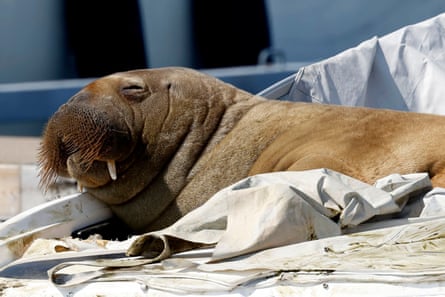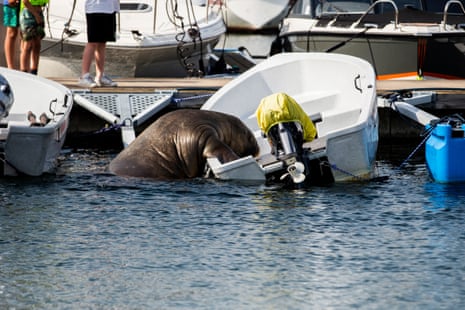For a week, a young female walrus nicknamed Freya has enchanted Norwegians by basking in the sun of the Oslo fjord, making a splash in the media and bending a few boats.
The 600kg (1,300lb) marine mammal has been named after the Norse goddess of love and beauty.
She has already been sighted in the UK, the Netherlands, Denmark and Sweden and has now chosen to spend part of the summer in Norway.

Freya first gained notoriety in Norway by climbing on to pleasure boats in Kragero, an idyllic southern coastal village, and has been doing the same in the waters of the capital since 17 July.
The presence of the mammal, which normally lives in the more northerly latitudes of the Arctic, has sparked curiosity among locals and made headlines in the press.
Newspaper Verdens Gang has put up a livestream of the walrus’s every move on its website.
Freya has been filmed chasing a duck and attacking a swan before, more often than not, dozing on boats struggling to support her bulk. A walrus can sleep up to 20 hours a day.
“It’s a pity about the material damage but that’s the way it is when you have wild animals,” Rolf Harald Jensen, a fisheries official, told broadcaster TV2, standing next to a hapless inflatable boat buckling under the animal’s weight.

After considering moving or even euthanising Freya if she were to pose a danger to the public, Norwegian authorities have decided to leave her in peace.
“She is doing well, feeding, resting and seems to be in good condition,” Norway’s Directorate of Fisheries said on Monday.
However, it emphasised the need for people to keep a distance and strongly advised against swimming or kayaking near Freya. “[She] is not necessarily as slow and ham-fisted as one might think when she is resting,” it said.
“A walrus is not normally a danger to humans as long as you keep a safe distance. But if it is disturbed by humans and doesn’t get the rest it needs, it may feel threatened and attack.”
The walrus is a protected species that feeds mainly on invertebrates such as molluscs, shrimps, crabs and small fish.
An adult male weighs around one tonne while a female weighs about 700kg.
